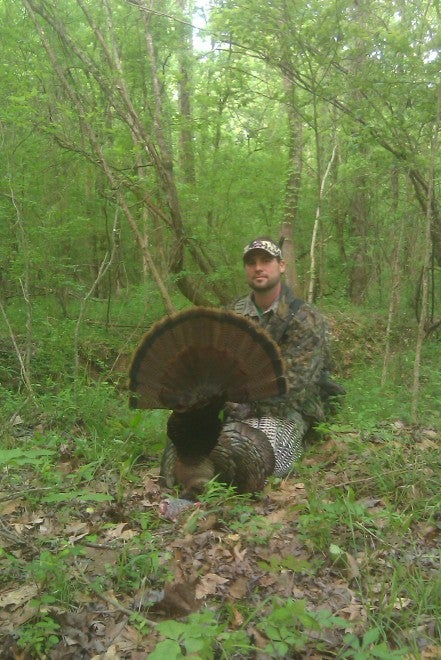Fast Paced Turkey Tactics Slowing Down
Dr. John Woods 03.16.15

Turkey tactics, strategies, and methods of hunting have come and gone over the years. One can still hear heated debates around the campfire, mostly during deer season, about how to best hunt a wild turkey gobbler. Some say to use this call or that, hunt morning roosted birds or afternoon love sick toms, use decoys or not, and so forth.
Some tactics have proven pretty successful over the span of time, while others have finally about played themselves out. Here is one I think should have been shelved long ago.
I can recall not so fondly the days of the turkey hunting “run and gun” movement. I was on a guided turkey hunt with a guy named George out of Aliceville, AL. George was a tall, sturdy, long legged, turkey running son-of-a-gun. His turkey hunting emphasis was on running.
One morning just at dawn’s early light, we stood on the edge of a wooded turkey mecca after a forced march from the truck. I could barely see the trail leading off the forest road into the thicket of turkey-dom. Heck, I could barely see George.
At the first gobble, George took off. I tried earnestly to keep pace, but that was a joke. I had no idea what we were doing or why, as George just tore off down the trail without as much as a word of guide guidance. Fairly soon I found myself standing alone on the trail with my guide nowhere in sight or sound. I could still hear the gobbler every so often, but he was way off.
As though a vision out of the mist, I could see George finally appearing from the dark woods. I cannot really put into print the words he shared with me, but the gist of it was this. “What in the —- are you doing?” was George’s first utterance. I replied exactly the same in kind. Then I gave him a moment to catch his breath. I bet a million bucks his face was as red as a beet, but I couldn’t tell in the shadows of first light.
“The idea here, John, is to run ahead of that gobbler and get into position in case he comes down out of the roost tree in our direction,” George choked.
I said, “What good would that do if your hunter is a hundred yards behind where you left him? It would be helpful if you had told me that before you bolted off into the woods.”
My idea was for the guide to put me in position to hunt the bird, not run my rear end ragged in the first minutes of the hunt, making a bunch of racket in the woods and having me all out of breath and too whipped to even settle into a shot. We later came to a full understanding of my expectations for him as the guide.
Not in three days of hunting with me and other hunters did George’s style of run and gun ever yield a turkey gobbler dead on the ground. I suppose maybe when he hunted on his own he had some success with that strategy. But I wonder, would he tell the truth about it?
“Okay, conceptually, the idea behind the run and gun tactic sounds pretty reasonable. The idea is to beat a path ahead of a gobbling tom moving in some known direction to set up for when he crosses the ambush spot elected by the hunter(s),” says long time turkey hunter Beau Starkey from Mississippi. “I have used this trick many times with moderate success, but you can get fooled by using it, too.”
“Just when you think you’ve got the upper hand on him, you might find yourself right in the middle of nothing and bust the gobbler completely out of the woods. Also it is darn hard to run ahead of a turkey on a steady move in the opposite direction. He’s moving in a more or less straight line, and the hunter has to zig-zag through the woods to gain enough ground to get ahead. Much easier said than done. His distance is shorter and he has the advantage. Often run and gun gobblers just disappear, especially if they quit gobbling.”
I’ve tried this too, and I am convinced a hunter is just as likely to run and gun too close to where the gobbler is moving and he either hears or sees you. Either way he shuts up and most likely turns to slip out the back door. They usually do this silently so you have no real idea where they went. And they most often will not answer another call for quite a while, if at all.
On more than one occasion I have even tried to quietly slip ahead of a bird that was gobbling but seemed to be holding still. I can’t tell you how many times I have ended up poking my head out into an open plot, field, trail, power line, or whatever, and he’s standing there looking at me. That’s the time to pack it up and head to new woods or home.
Far and ahead of running and rarely gunning, turkey hunting still seems to work best with a solid set up, meaningful calling, and a wait and see approach. If your scouting tells you where a bird is roosted or where he is likely to go after he pitches down from the roost, then your best bet is to set up there in a ground blind or securely against a big tree with knees up and the gun held at the ready. Your best bet is to call that bird to the gun instead of trying to run him down, which you can rarely do anyway. Maybe it’s time to put the run and gun to rest.